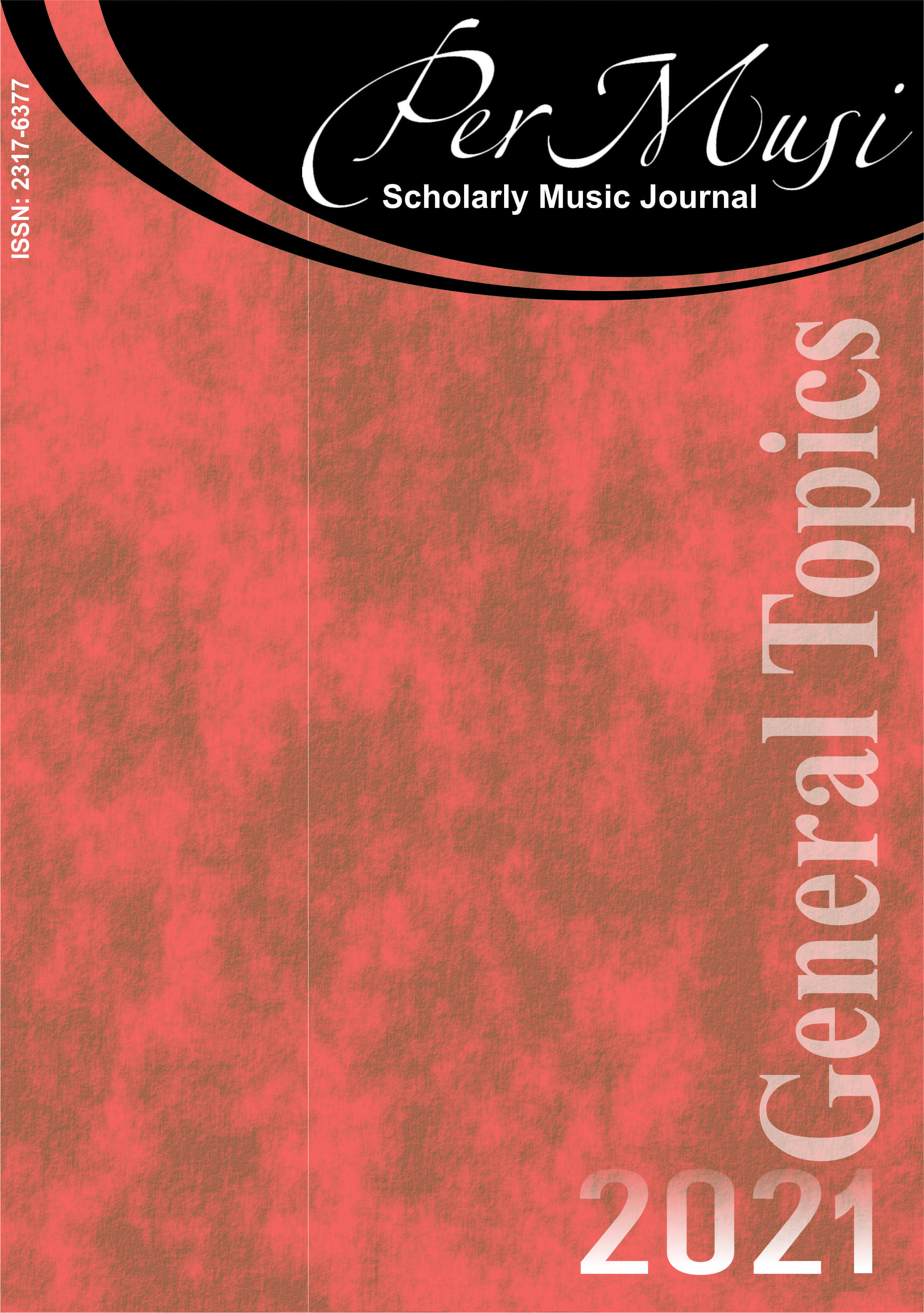Gesto Musical e Transcendência em Nigun de Bloch
DOI:
https://doi.org/10.35699/2317-6377.2021.33956Palavras-chave:
Ernest Bloch, Nigun, Performance, Devekut, Gesto musicalResumo
Ernest Bloch compôs em 1923 a obra “Baal Shem: Three Pictures of Chassidic Life”, constituída por três movimentos representativos do imaginário hassídico, respetivamente “Vidui”, “Nigun” e “Simchas Torah”. O segundo movimento tornou-se uma peça amplamente conhecida e incorporada ao repertório de violinistas. Bloch associa o nigun, interpretado pela voz humana, ao violino, colocando-o no lugar do Cantor ou Rabino. O violino incorpora o personagem orante que caracteriza o nigun, inclusive no gestual, utilizando a música como um veículo da materialidade para a transcendência (devekut). Através da análise expressiva, o presente ensaio pretende evidenciar as similaridades entre a composição “Nigun” e o género musical homónimo, ressaltando o gesto musical e a liberdade interpretativa, e despertar algumas reflexões sobre o tema, sem a pretensão de apresentar respostas definitivas ou conclusivas.
Referências
Albrecht, Joshua. 2018. “Expressive Meaning and the Empirical Analysis of Musical Gesture: The Progressive Exposure Method and the Second Movement of Beethoven's Pathetique Sonata”. Music Theory Online, 24 (3). Disponível em: https://mtosmt.org/issues/mto.18.24.3/mto.18.24.3.albrecht.html
Avenary, Hanoch. 1964. “The Hasidic Nigun. Ethos and Melos of a Folk Liturgy”. Journal of the International Folk Music Council, 16: 60-63. Disponível em: 10.2307/835078.
Bloch, Ernest. 2001. “Baal Shem”. Music for Violin and Piano. Nova Iorque: Carl Fischer: 27-45.
Bloch, Ernest, e Frank, Waldo. 1933. “Man and Music”. The Musical Quaterly, 19 (4): 374-381. Disponível em: http://www.jstor.org/stable/739062
Bloch, Suzanne. 1976. Ernest Bloch: Creative Spirit. New York City: Jewish Council of the Jewish Welfare Board.
Cook, Nicholas. 1999. “Analysing Performance and Performing Analysis”. Rethinking music. Eds. Cook, N., & Everist, M. Oxford: Oxford University Press: 239-261.
Gollance, Sonia Beth. 2019. “Gesture, Repertoire, and Emotion: Yiddish Dance Practice in German and Yiddish Literature”. Jewish Social Studies: History, Culture, Society, 25 (1) Disponível em: 10.2979/jewisocistud.25.1.04
Hatten, Robert. 2004. Interpreting Musical Gestures, Topics, and Tropes: Mozart, Beethoven, Schubert. Bloomington: Indiana University Press.
Hatten, Robert. 2019. “Performance and Analysis - Or Synthesis: Theorizing Gesture, Topics, and Tropes in Chopin's F-Minor Ballade”. Indiana Theory Review, 28 (1/2): 45-66.
Johnson, Eric. (1972). “A Composer's Vision photographs by Ernest Bloch”. Aperture, 16 (3), 63. Disponível em: 10.2307/24471023
Knapp, Alexander. 1970-1971. “The Jewishness of Bloch: Subconscious or Conscious?”. Proceedings of the Royal Musical Association, 97: 99-112.
Kushner, David. 2010. “Ernest Bloch. The Cleveland Years”. Min-Ad – Israel Studies in Musicology Online, 8(II): 175-200.
Lazar, Aryeh. 2017. “A Reexamination of the Structure of the Inward Outward Upward Prayer Scale”. The International Journal for the Psychology of Religion, 27 (3): 141–153. Disponível em: 10.1080/10508619.2017.1313014
Maróthy, Janos. 1993-1994. “Rite and Rhythm. From Behaviour Patterns to Musical Structures”. Studia Musicologica Academiae Scientiarum Hungaricae, 35 (4): 421-433. Disponível em: 10.2307/902316
Mayse, Ariel Evan, e Reiser, Daniel. 2018. “Territories and Textures: The Hasidic Sermon as the Crossroads of Language and Culture”. Jewish Social Studies, 24 (1): 127-160. Disponível em: 10.2979/jewisocistud.24.1.05
Östersjö, Stefan. 2016. “Go To Hell: Towards a Gesture-Based Compositional Practice”. Contemporary Music Review, 35 (4–5): 475–499. Disponível em: 10.1080/07494467.2016.1257625
Robinson, Jenefer, e Hatten, Robert. 2012. “Emotions in Music”. Music Theory Spectrum, 34 (2): 71-106. Disponível em: 10.1525/mts.2012.34.2.71
Rubin, Joel. 2005. "Music Is the Pen of the Soul: Recent Works on Hasidic and Jewish Instrumental Klezmer Music”. AJS Review, 29 (1): 145-158. Disponível em: 10.2307/4131814
Schleifer, Ronald. 2019. “Modernism as Gesture: The Experience of Music, Samuel Beckett, and Performed Bewilderment”. Criticism, 61 (1): 73-96. Disponível em: 10.13110/criticism.61.1.0073
Seroussi, Edwin. 2017. “Shamil: Concept, Practice and Reception of a Nigun in Habad Hasidism”. Studia Judaica, 20, 2(40): 287–306. Disponível em: 10.4467/24500100STJ.17.013.8248
Publicado
Edição
Seção
Licença
Copyright (c) 2021 Per Musi

Este trabalho está licenciado sob uma licença Creative Commons Attribution 4.0 International License.

Exceto onde está indicado, o conteúdo neste site está sob uma Licença Creative Commons - Atribuição 4.0 Internacional.












